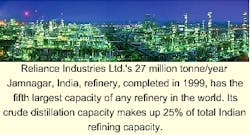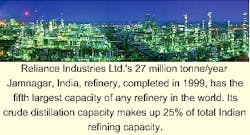Refinery project delays a mixed blessing for India
Slow progress may be a mixed blessing for Indian refining projects because the country is headed for a supply glut if projects planned for the next 4 years are completed on time.
Adherence to schedule is unlikely, however, because a lack of partners and reorganization of government refining assets are encouraging refiners to reconsider their plans. Despite various delays, construction for most new Indian refineries is back on track.
Table 1 lists planned grassroots refineries in India, including those completed in 1999. Table 2 lists planned crude-distillation expansions.
Yearend 2003 capacity will be an almost three-fold increase of India's capacity since the beginning of 1999. Current refining capacity in India is 107 million tonnes/year (tpy).
Chem Systems, White Plains, NY, in its annual review of the Asian refining industry, estimated that India needs an additional 57 million tpy of capacity by 2010 to satisfy its future domestic consumption. New grassroots capacity is expected to contribute 47.5 million tpy to Indian refining capacity by 2005. Expansions will contribute another 21 million tpy.
With a 53 million tpy jump in refining capacity in 1999 and 2000 and lower than expected demand for diesel in the past year, India found itself an exporter of diesel in 2000.
Hydrocarbon Vision 2025, an Indian report released in March 2000, suggested increasing the country's refining capacity by 360 million tpy to meet 90% of India's middle-distillate demand in 2025. Following recommendations from this report to encourage foreign participation, the government increased its 49% limit on foreign investment in refining projects to 100% last year (OGJ, Apr. 10, 2000, p. 32).
The government's ninth 5-year plan was more cautious, however; it warned investors to limit grassroots projects to economically viable ones. Weak refining margins and deregulation in April 2002, it said, will be challenges for future refining operations.
1999 success
The Indian refining industry managed several successful grassroots projects in 1999. Three refineries were commissioned that year: Reliance Petroleum Ltd.'s 27 million tpy Jamnagar refinery, Indian Oil Corp.'s 6 tpy Panipat refinery, and Numaligarh Refinery Ltd.'s 3 million tpy Assam refinery.
These refineries did not come on line without some woe, however. Construction of the Reliance refinery was accompanied by constant changes in scope. Although there was speculation that a leaking pipeline which prevented use of the single point mooring facility would delay commissioning in 1999, the refinery came on stream earlier than expected.
Indian Oil Corp. Ltd. (IOC) Panipat's troubles started near and after its commissioning date. A fire in its vacuum unit in late 1998 delayed commissioning of the plant. A few months later in 1999, a blast in the hydrocracking unit claimed five lives.
Numaligarh said its refinery was shut down for maintenance at the end of 1999. Although it was commissioned in 1999, the plant operated at an average 4.5% of installed capacity during April to December 1999 (OGJ, Jan. 31, 2000, p. 32).
Lost partners
Government incentives have not been enough to encourage foreign investment, or local investment for that matter, in Indian refining projects.
Perhaps the most notorious of delayed Indian refining projects is Essar Oil Ltd.'s 10.5 million tpy refinery in Vadinar, in Jamnagar, Gujarat. Since its inception in 1993, the project has postponed start-up from 1998 to 1999 to now, end of 2001.
In June 1998, a cyclone hit the Gujarat coast, delaying refinery completion by a year. Workers were sent home in March 1999 because the company lacked receipt of loans. Since that time, the refinery has lacked the normal work activity associated with building a new refinery.
Although funding by Industrial Development Bank of India and ABB Lummus Crest has helped fulfill Essar's equity requirements and the refinery is more than 50% complete, work is not expected to recommence until February. These dates will likely push back the scheduled commissioning date.
Essar has been working diligently to acquire a partner for its refinery project. Its first two choices, Bharat Petroleum Corp. Ltd. (BPCL) and IOC, declined the opportunity, but Oman Oil Corp., tired of environmental clearance delays regarding BPCL's Bina, Madhya Pradesh, refinery, is considering dropping its stake in the Bina venture for Essar's project (OGJ Online, Nov. 1, 2000).
The Essar venture is attractive to Oman Oil because the Bina refinery is not scheduled to be completed until 2004, but Essar's refinery is scheduled for 2001. Should Oman Oil pull out of the Bina project, BPCL would be the sole project owner. This project is in trouble as BPCL expressed reluctance in December 2000 to continue this project on its own.
This would not be the first time Oman Oil had second thoughts about an Indian refining project. In 1998, it dissolved its joint venture with Hindustan Petroleum Corp. Ltd. (HPCL) to build a 6 million tpy refinery on the west coast of India, in Ratnagiri, Maharashtra. Plans for this west coast refinery, originally one of the three joint-venture projects proposed by the Indian government in 1992, were abandoned in 1998.
Of the three government-endorsed JV projects, IOC's east coast Paradip, Orissa, refinery has the most hope of completion. The project did, however, run into shaky ground when the Orissa state government last year withdrew a sales tax exemption on which IOC had counted. IOC would not confirm if the exemption has been reinstated.
The future of the third proposed refinery, BPCL's Bina refinery, to be located in central India, is bleak, and may follow the footsteps of the west coast refinery plans.
BPCL suffers from a lost partner in its Sultanpur, Uttar Pradesh, 7 million tpy planned grassroots plant in central India. Bharat Shell Ltd., originally an owner in the plant, pulled out of the project in 1998. Although BPCL originally said it would stick with the plan to build the refinery regardless of Shell's decision, it is currently considering if it should do just that.
Projects in progress
HPCL's 9 million tpy grassroots refinery, planned in Phulo Khari, in the district of Bhatinda in the state of Punjab, ran into rough waters when Exxon Corp., then Saudi Aramco, and then TotalFina, found the partnership unattractive.
The refinery, to be commissioned in 2004, had good news at the end of 2000, however. The Indian government approved funds and gave its confidence in the company's ability to begin refinery construction without a partner.
IOC, in planning its grassroots Paradip refinery, experienced the pulling out of its partner, Kuwait Petroleum Corp., in 1999. Like the other Indian refiners, IOC has decided to continue on its own while it woos other partners.
Another project that is on its way belongs to Nagarjuna Oil Corp. The firm is planning a 6 million tpy refinery in the southern part of India, in Cuddalore, Tamil Nadu. The new refinery will be the result of relocating a former Mobil Corp. refinery from Woerth, Germany.
Nagarjuna Oil is looking for a marketing partner, and IOC is considering a stake in this refinery. It is close to Nagapattinam, Tamil Nadu, where IOC cancelled its plans for an 8 million tpy grassroots refinery last year. The crux of its decision was the government's plan to sell its 53% stake of Chennai Petroleum Corp, formerly called Madras Refineries Ltd., to IOC. The acquisition of this 6.5 million tpy refinery gives IOC a production facility in southern India, negating its need for the Nagapattinam plans.




